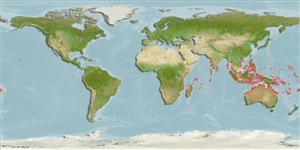Common names from other countries
>
Acanthuriformes (Surgeonfishes) >
Acanthuridae (Surgeonfishes, tangs, unicornfishes) > Acanthurinae
Etymology: Acanthurus: Greek, akantha = thorn + Greek, oura = tail (Ref. 45335).
More on author: Randall.
Environment: milieu / climate zone / depth range / distribution range
Ecologia
marinhas associadas(os) a recifes; intervalo de profundidade 1 - 20 m (Ref. 90102). Tropical; 20°N - 25°S, 35°E - 172°W
Western Indian Ocean: Mozambique (Ref. 41878). Indo-West Pacific: Seychelles (Ref. 10685), Philippines, Indonesia and Great Barrier Reef; recently found in Maldives. Reported from Malaysia (Ref. 5756) and Samoa (Ref. 592).
Tamanho / Peso / Idade
Maturity: Lm ? range ? - ? cm
Max length : 45.0 cm SL macho/indeterminado; (Ref. 48637); idade máx. registrada: 30 anos (Ref. 52229)
Espinhos dorsais (total) : 9; Raios dorsais (total) : 25 - 26; Espinhos anais: 3; Raios anais : 23 - 24. Color in life dark brown; orange brown from pectoral base downward; caudal spine socket bright orange; orange blotch before and behind pupil; caudal fin base with a white band. Anterior gill rakers 20-23, posterior 24-28. Large caudal spine, 2.2 - 4.4 in head.
Adults inhabit shallow reefs, both in lagoons and outer reef areas. They frequently move in groups. Juveniles found between soft corals in lagoons at depths of up to 2 m (Ref. 9710, 48637). Adults in groups, often mixed with other similar species (Ref. 48637).
Ciclo de vida ou comportamento de acasalamento
Maturities | Reprodução | Spawnings | Egg(s) | Fecundities | Larvas
Randall, J.E., 1956. A revision of the surgeonfish genus Acanthurus. Pac. Sci. 10(2):159-235. (Ref. 1920)
Status na Lista Vermelha da UICN (Ref. 130435)
CITES (Ref. 128078)
Not Evaluated
Ameaça para os humanos
Harmless
Uso pelos humanos
Pescarias: espécies comerciais
Ferramentas
Relatórios especiais
Baixar XML
Fontes da internet
Estimates based on models
Preferred temperature (Ref.
115969): 25.6 - 29.3, mean 28.5 (based on 2408 cells).
Índice de diversidade filogenética (Ref.
82804): PD
50 = 0.5000 [Uniqueness, from 0.5 = low to 2.0 = high].
Bayesian length-weight: a=0.02344 (0.01103 - 0.04981), b=2.96 (2.79 - 3.13), in cm Total Length, based on LWR estimates for this Genus-body shape (Ref.
93245).
Nível Trófico (Ref.
69278): 2.0 ±0.1 se; based on size and trophs of closest relatives
Resiliência (Ref.
120179): Baixo, tempo mínimo de duplicação da população 4,5 - 14 anos (tmax=30; K=0.67).
Fishing Vulnerability (Ref.
59153): Low to moderate vulnerability (26 of 100).
